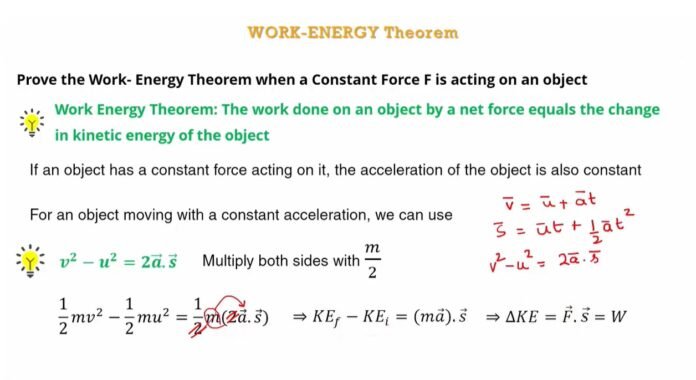Work is a common concept in physics and everyday life. Work done on an object is the product of the force applied and the displacement of the object in the direction of the force. However, work is more than just a mathematical product. It is a fundamental concept that helps us understand how energy is transferred between objects. The work-energy theorem is a fundamental principle of physics that relates the work done on an object to the change in its kinetic energy.
Work Energy Theorem
The work-energy theorem is a fundamental principle of physics that relates the work done on an object to the change in its kinetic energy. Through the derivation process, we can see that the theorem is based on the fundamental laws of motion, particularly Newton’s second law. The work-energy theorem is widely applicable in many fields of physics, including mechanics, electromagnetism, and thermodynamics. It is a powerful tool for understanding the transfer of energy between objects and is an essential concept for any student of physics to understand.
Work is therefore the outcome of force and displacement. We are aware that things in motion have kinetic energy. This develops the “Work-Energy Theorem,” which establishes a relationship between work and kinetic energy. It is written as
Where is the amount of work done in joules , and is the change in the object’s kinetic energy.
Each of us works every day, though some more than others. Nonetheless, everyone needs energy regardless of how much or how little they work. The Work-Energy Theorem is introduced at this point.
We now talk about what work actually is, which is when a force acts on a body or an object to cause movement in that object or body. In some cases, the direction is not always the same. In actuality, it is not a guarantee that the force’s direction and the direction of the body or object after it is applied will match.
Hence, when a given body or item is subjected to a force and changes position as a result, work has been accomplished. This also implies that they move and cover a specific distance in response to the force used.
The phenomena further solidifies the connection between Kinetic Energy and Work that already exists. The Work-Energy Theorem is essentially the name for this relationship.
That will provide a clear and easy explanation of the Workings of a Work-Energy Theorem.
Kinetic Energy
Before we delve into the derivation of the work-energy theorem, it is essential to understand kinetic energy. Kinetic energy is the energy an object possesses due to its motion. The kinetic energy of an object can be calculated using the following formula:
whereis the kinetic energy,is the mass of the object, and is its velocity.
Work
Work, on the other hand, is the energy transferred to or from an object by a force acting on it. Work done on an object is given by the following formula:
where is the work done, is the force applied, is the displacement of the object, and is the angle between the force and the displacement.
Derivation of the Work-Energy Theorem
The motion equations suggest that,
Where,
stands for the object’s end velocity, for its starting speed, for continuous acceleration, and for its displacement.
The aforementioned equation can be expressed as
By substituting the vector quantities’ values, we obtain;
We will obtain the following by multiplying to both sides of the equation.
Newton’s second law states that, hence the equation above can be written as;
As we know that,
and
The equation now reads as follows:
Thus, we have
where, (change in Kinetic Energy)
The Work-Energy Theorem is derived in this way. As a result, we may state that the amount of work done on an item is equal to the change in the object’s kinetic energy.
Recommended Articles:
Derivation Of Prism Formula
Derivation Of Schrodinger Wave Equation
Derivation of the Terminal Velocity
Derivation of Torsion Equation
Van Der Waals Equation
